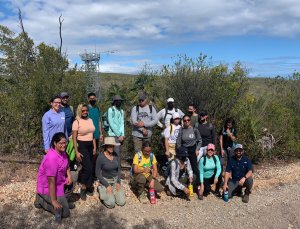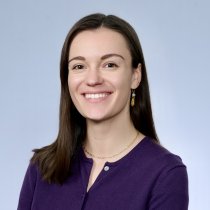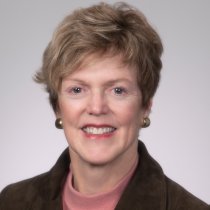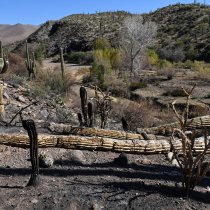Spotlight
Domain Digest No. 5: ESA's SEEDS students visit Puerto Rico
May 25, 2022
In Spring 2022, the ESA SEEDS program took a regional field trip to the NEON field sites in Puerto Rico. It was the first SEEDS in-person event since September 2019, when SEEDS hosted a Leadership Meeting at the Virginia Coastal Reserve.
SEEDS (Strategies for Ecology Education, Diversity and Sustainability) – which last year celebrated its 25th anniversary – is an education program by the Ecological Society of America (ESA). Students participating in SEEDS receive engaging and hands-on ecological experiences developed for mainly undergraduates. The goal is to enable diverse students to learn more about ecological sciences and the many ways in which they could pursue Ecology as a career path.
"Ecology field trips are the cornerstone through which SEEDS introduces diverse students to the range of ecological systems and research in the United States," says the SEEDS website. In its 25 years, SEEDS has hosted 73 travel experiences for students and coordinated 1871 student travel awards for meetings.
In Puerto Rico, SEEDS students joining a regional field trip toured the Guanica Dry Forest Site (GUAN – Domain 04). "We were really excited to have this field trip finally happen," says Wilmarie Plaza-Muniz, technician specialist in NEON's Puerto Rico Domain. "It was fantastic to have all the SEEDS students there and to be able to answer their questions about ecological data and what NEON is capable of."
We asked Fred Abbott, Diversity Program manager at SEEDS, about the trip. He joined the students and SEEDS chapters in visiting the NEON site and interacting with NEON staff.
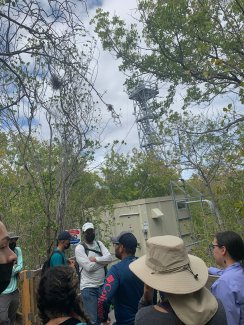
Walter Ruiz talking about the GUAN Tower.
SEEDS hosts trips to many interesting ecosystems and partners with a lot of different organizations - why NEON's Puerto Rico network? What interested you about NEON?
Sandra del Rio, our Professional Programs Coordinator with SEEDS and ESA, reached out to NEON in the first place to help organize this experience. This field trip was in conjunction with three SEEDS Chapters in Puerto Rico – UPR Bayamón, UPR Humacao, and UPR Mayagüez. We reached out to our chapter network there, and these chapters responded that they would be interested in learning more about big data management and public access to the NEON data. NEON brings an exciting new approach and scale to the science of ecology. We want to make sure our SEEDS students are aware of these new developments and how they can be part of the data revolution in ecology.
How did the field trip go?
It was a great experience for both staff and students! The NEON Staff in Puerto Rico joined us in the morning for a workshop and answered questions – what is NEON, what do these towers do, how can you access the data, and what can you do with that data. After the workshop, we had lunch and headed over to the Bosque Seco de Guánica where the large tower is located. We learned about the biodiversity of this unique ecosystem in Puerto Rico, they showed us the infrastructure of the tower, cool data that has been published already and answered a ton of questions from our students about remote data sensing and big data management.
What NEON staff did you meet and talk with?
It seems like we talked to all the NEON staff in Puerto Rico! We had four NEON staff including Wilmarie Plaza-Muñiz, technician specialist-botanist (who helped put this all together); Jean Sandoval, operations manager; Arlene Megill Irizarry, senior field technician; and Walter Ruiz Ortiz, field technician.

Arlene Megill showing students how NEON staff set mosquito traps and the purpose of collecting the data.
Did the students find anything particularly interesting or new?
They learned that it's possible to compile data without going to the field. Students expressed that they were impressed that there are structures in Puerto Rico focused on that region's local dry environment, which is less heard of than the El Yunque Rainforest and the Arecibo Observatory, for example. They also enjoyed actively learning and observing how you can study ecology with expensive tools, but also with $2 equipment. Additionally, they learned about the flora and fauna of the Guánica Dry Forest and reinforced ecological terminology.
Have the students expressed in continuing in an ecology career?
They have, this is part of the mission of the SEEDS program. Additionally, they gained insight on ecology-related careers from NEON employees and network with them. They were very excited about the prospect of using NEON data with their current research projects.
What do you think are the biggest benefits for both the guides and students participating in SEEDS trips?
The close community we create with our students. Students are always amazed when exposed to areas and careers in ecology that are outside of their regular academic settings. We also connect them with a wide network of ecologists for information on graduate school and potential graduate advisers.
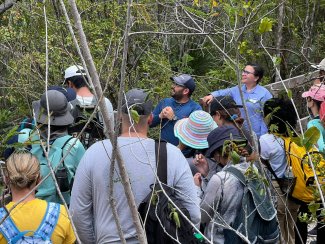
Walter Ruiz and Wilmarie Plaza-Muniz talking about the GUAN tower.
What do you think are the next steps for these students?
That depends on their own goals. Some would venture through the academic paths into graduate school and beyond, but most will find careers outside of the academic setting. We envision them working for a non-profit, local-state-federal government, or in the private sector as consultants and technicians. Hopefully some of them will find fulfilling careers within organizations such as NEON.
How can other students find out more and participate in ESA SEEDS?
They can go to the SEEDS website, follow us on social media (@esa.seeds on Instagram and ESASEEDS on Facebook), or email us at seeds@esa.org.
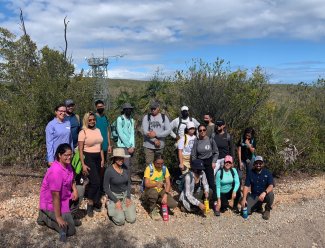
D04 staff and students from the ESA's SEEDS chapters at NEON's GUAN site in Puerto Rico. The field trip was held in March 2022.
